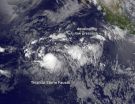(Press-News.org) VIDEO:
The animation begins with global infrared data showing the progression of the storm as it forms into a hurricane. Then GPM flies overhead measuring rain rates on the ground. GPM's...
Click here for more information.
The Global Precipitation Measurement (GPM) Core Observatory flew over Hurricane Arthur five times between July 1 and July 5, 2014. Arthur is the first tropical cyclone of the 2014 Atlantic hurricane season.
GPM is a joint mission between NASA and the Japan Aerospace Exploration Agency. The Core Observatory was launched Feb. 27 from Japan and began its prime mission on May 29, just in time for the hurricane season.
The five GPM passes over Arthur are the first time a precipitation-measuring satellite has been able to follow a hurricane through its full life cycle with high-resolution measurements of rain and ice. In the July 3 image, Arthur was just off the coast of South Carolina. GPM data showed that the hurricane was asymmetrical, with spiral arms, called rain bands, on the eastern side of the storm but not on the western side.
Arthur was born as the first 2014 Atlantic tropical depression on June 30. It strengthened into a tropical storm on July 1 and reached maximum intensity as a Category 2 hurricane on July 4. The storm moved up the U.S. East Coast and made landfall on July 3 at 11:15 p.m. EDT over the Shackleford Banks between Cape Lookout and Beaufort, North Carolina, before swinging northeast over the ocean toward Greenland, where it became an extra-tropical storm on July 5.
"With these new observations we are able to see fine scale structures of precipitation to about 1,000 feet vertically and 3 miles horizontally. This allows us to measure precipitation regionally and to improve weather forecasting models," said Gail Skofronick-Jackson, GPM project scientist at NASA's Goddard Space Flight Center in Greenbelt Maryland.
The GPM Core Observatory's observations of storms like Arthur will also help scientists decipher some of the thorniest questions about hurricanes, such as how and why they intensify. Hurricane intensity is one of the most difficult aspects to predict and is an area of active research that GPM's observations will contribute to, said NASA Goddard hurricane researcher Scott Braun.
The spacecraft carries two instruments that show the location and intensity of the rain, which defines a crucial part of the storm structure. The GPM Microwave Imager sees through the tops of clouds to observe how much and where precipitation occurs, and the Dual-frequency Precipitation Radar observes precise details of precipitation in three dimensions.
With the added capability and higher resolution on the new instruments, "hurricane features pop out more. They're sharper, there's more clarity to the structures," said Braun. "Being able to see the structures more clearly may allow for better determination of the structure of the eye wall and rainbands, thereby providing clues about the likelihood of a storm intensifying or weakening."
For forecasters, GPM's radiometer and radar data are part of the toolbox of satellite data that they use to monitor tropical cyclones and hurricanes. This toolbox includes data from other low Earth orbit and geostationary satellites.
"The whole idea here is to use these tools to understand the initial genesis of the tropical cyclone, then to monitor its location, eye structure and intensity as it evolves, and to use that along with our numerical model forecast to generate a five- to seven-day forecast every six hours," said Jeff Hawkins, head of the Satellite Meteorological Applications Section for the Naval Research Laboratory in Monterey, California. His group is an early adopter of GPM data and monitors near-real time tropical cyclones worldwide. They distribute satellite products generated from multiple satellites' data to operational and research users, including the Navy and Air Force's Joint Typhoon Warning Center in Hawaii and the U.S. National Hurricane Center in Florida.
The addition of GPM data to the current suite of satellite data is timely. Its predecessor precipitation satellite, the Tropical Rainfall Measuring Mission, is in the17th year of its operation. GPM's new high-resolution microwave imager data and the unique radar data ensure that forecasters and modelers won't have a gap in coverage.
INFORMATION:
All GPM data products will be released to the public by Sept. 2, 2014. Current and future data sets are available to registered users from NASA Goddard's Precipitation Processing Center website at: http://pps.gsfc.nasa.gov/
NASA-JAXA's new precipitation satellite sees first Atlantic hurricane
2014-07-08
ELSE PRESS RELEASES FROM THIS DATE:
Satellite sees newborn Tropical Storm Fausto being 'chased'
2014-07-08
Tropical Storm Fausto was literally born yesterday and strengthened to a tropical storm quickly. Satellite imagery from NOAA's GOES-West satellite shows a rounded Fausto being "chased" by a developing area of low pressure to the east of the storm.
NOAA's Geostationary Operational Environmental Satellite GOES-West captured a combination visible and infrared image of the Eastern Pacific on July 8 at 1500 UTC (10 a.m. EDT). In the image, Tropical Storm Fausto appeared as a rounded area of clouds, compared to the amorphous developing low pressure area behind it.
At 6:30 ...
NCI study finds extreme obesity may shorten life expectancy up to 14 years
2014-07-08
Adults with extreme obesity have increased risks of dying at a young age from cancer and many other causes including heart disease, stroke, diabetes, and kidney and liver diseases, according to results of an analysis of data pooled from 20 large studies of people from three countries. The study, led by researchers from the National Cancer Institute (NCI), part of the National Institutes of Health, found that people with class III (or extreme) obesity had a dramatic reduction in life expectancy compared with people of normal weight. The findings appeared July 8, 2014, in ...
Virtual reality crowds produce real behavior insights
2014-07-08
VIDEO:
Researchers at Brown University have developed a wireless virtual reality system to better understand how pedestrians interact with one another and generate patterns of crowd movement.
Click here for more information.
PROVIDENCE, R.I. [Brown University] —The cognitive scientists in the Virtual Environment Navigation lab at Brown University are not only advancing a frontier of behavioral research but also of technology.
Led by Professor William Warren, the group developed ...
Three reforms to protect California's cap-and-trade policy
2014-07-08
California's landmark cap-and-trade system for regulating greenhouse gases could be vulnerable to price spikes and market manipulation, according to a new study released by scholars affiliated with the Energy Institute at Haas. But the state's air-quality regulators can prevent that outcome with three straightforward reforms, the study says.
Specifically, the California Air Resources Board should consider (1) strengthening the new market's price collar—the so-called allowance price containment reserve—(2) allowing permits to be converted from one compliance period to ...
Planet Mercury a result of early hit-and-run collisions
2014-07-08
TEMPE, Ariz. - Planet Mercury's unusual metal-rich composition has been a longstanding puzzle in planetary science. According to a study published online in Nature Geoscience July 6, Mercury and other unusually metal-rich objects in the solar system may be relics left behind by collisions in the early solar system that built the other planets.
The origin of planet Mercury has been a difficult question in planetary science because its composition is very different from that of the other terrestrial planets and the moon. This small, innermost planet has more than twice ...
Using sand to improve battery performance
2014-07-08
RIVERSIDE, Calif. (http://www.ucr.edu) — Researchers at the University of California, Riverside's Bourns College of Engineering have created a lithium ion battery that outperforms the current industry standard by three times. The key material: sand. Yes, sand.
"This is the holy grail – a low cost, non-toxic, environmentally friendly way to produce high performance lithium ion battery anodes," said Zachary Favors, a graduate student working with Cengiz and Mihri Ozkan, both engineering professors at UC Riverside.
The idea came to Favors six months ago. He was relaxing ...
UI researchers find early predictor for preeclampsia
2014-07-08
University of Iowa researchers have discovered a biomarker that could give expecting mothers and their doctors the first simple blood test to reliably predict that a pregnant woman may develop preeclampsia, at least as early as 6 weeks into the pregnancy.
Preeclampsia is a cardiovascular disorder generally occurring late in pregnancy and often resulting in an early delivery, creating immediate and potentially lifelong risks to both mother and baby. It causes high blood pressure and protein in the urine, and is typically diagnosed in the late second or third trimester ...
Solar energy gets a boost
2014-07-08
RIVERSIDE, Calif. — A perspective article published last month by University of California, Riverside chemists in the Journal of Physical Chemistry Letters was selected as an Editors Choice—an honor only a handful of research papers receive. The perspective reviews the chemists' work on "singlet fission," a process in which a single photon generates a pair of excited states. This 1->2 conversion process, as it is known, has the potential to boost solar cell efficiency by as much as 30 percent.
Applications of the research include more energy-efficient lighting and photodetectors ...
Three NASA satellites dissect powerful Typhoon Neoguri
2014-07-08
VIDEO:
NASA's TRMM Satellite Sees Heavy Rainfall in Typhoon Neoguri On July 7 at 2:41 a.m. EDT the TRMM satellite had a near perfect view as it passed above the center...
Click here for more information.
NASA's Aqua, TRMM and CloudSat dissected powerful Typhoon Neoguri as it moved through the Northwestern Pacific Ocean and affected southern Japan. The three satellites gathered data on rainfall, cloud heights, cloud extent, cloud temperatures, the size of the eye, and what was ...
Poll finds health most common major stressful event in Americans' lives last year
2014-07-08
Princeton, N.J. – A new NPR/Robert Wood Johnson Foundation/Harvard School of Public Health (HSPH) poll released today that examines the role of stress in Americans' lives finds that about half of the public (49%) reported that they had a major stressful event or experience in the past year. Nearly half (43%) reported that the most stressful experiences related to health.
More than half of those who experienced a great deal of stress in the past month say too many overall responsibilities and financial problems were contributors (54% and 53% respectively). More than a ...







